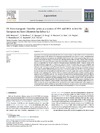Identificador persistente para citar o vincular este elemento:
https://accedacris.ulpgc.es/handle/10553/74434
| Título: | Oil from transgenic Camelina sativa as a source of EPA and DHA in feed for European sea bass (Dicentrarchus labrax L.) | Autores/as: | Betancor, M.B. MacEwan, A. Sprague, M. Gong, X. Montero, D. Han, L. Napier, J.A. Norambuena, F. Izquierdo, M. S. Tocher, D. R. |
Clasificación UNESCO: | 310502 Piscicultura | Palabras clave: | EPA DHA Camelina Seabass Fish oil |
Fecha de publicación: | 2021 | Proyectos: | AQUAculture infrastructures for EXCELlence in EUropean fish research 3.0 | Publicación seriada: | Aquaculture | Resumen: | Aquaculture, the fastest growing food production sector cannot continue to rely on finite stocks of marine fish as the primary source of the omega-3 (n-3) long-chain polyunsaturated fatty acids (LC-PUFA), eicosapentaenoic acid (EPA; 20:5n3) and docosahexaenoic acid (DHA; 22:6n-3), for feeds. A four-month feeding trial was conducted to investigate the impact of a de novo oil, with high levels of EPA and DHA, obtained from transgenic Camelina sativa on growth performance, tissue fatty acid profiles, and expression of lipid metabolism genes when used as a replacement for fish oil in feed for European seabass (Dicentrachus labrax). Triplicate groups of 50 juvenile fish (initial weight 16.7 ± 0.92 g) per tank were fed for 4 months with one of three isolipidic and isoproteic experimental diets consisting of a standard diet containing a commercial blend of fish oil and rapeseed oil (CFO), a diet containing transgenic Camelina oil (TCO), or a blend of fish oil and rapeseed oil with enhanced levels of EPA and DHA (EFO) formulated to match the n-3 LC-PUFA profile of the TCO feed. Final weight of fish fed the GM-derived oil was not different to fish fed either CFO or EFO. Slight lower growth performance of fish fed TCO at the beginning of the trial was related to transient reduced feed intake, possibly caused by glucosinolates in the raw Camelina sativa oil. The GM-derived oil improved the nutritional quality of the fish fillet by enhancing total n-3 PUFA levels compared to the fish fed the other two feeds, and maintained flesh EPA and DHA at the same levels as in fish fed the diets containing fish oil. The metabolic response in liver and intestine was generally relatively mild although diets TCO and EFO seemed to trigger a metabolic response consisting of an up-regulation of both β-oxidation (cpt1a) and fatty acid transport (fabp1), possibly reflecting higher levels of LC-PUFA. Overall, the present study indicated that an oil of terrestrial origin, Camelina sativa, when engineered to contain high levels of EPA and DHA can replace fish oil in feeds for European seabass with no detrimental impact on growth or feed efficiency, while also maintaining or increasing tissue n-3 LC-PUFA contents. | URI: | https://accedacris.ulpgc.es/handle/10553/74434 | ISSN: | 0044-8486 | DOI: | 10.1016/j.aquaculture.2020.735759 | Fuente: | Aquaculture [ISSN 0044-8486], n. 530, 735759 (Enero 2021) |
| Colección: | Artículos |
Los elementos en ULPGC accedaCRIS están protegidos por derechos de autor con todos los derechos reservados, a menos que se indique lo contrario.
